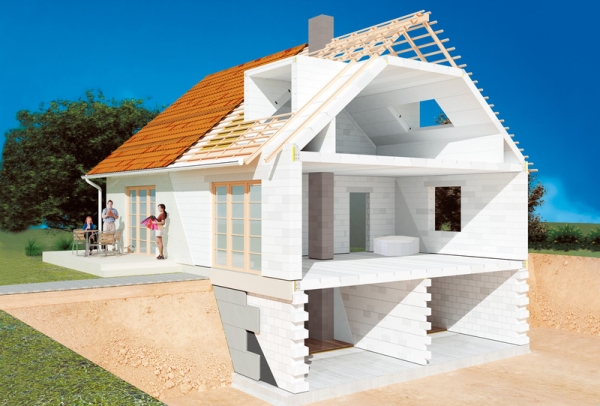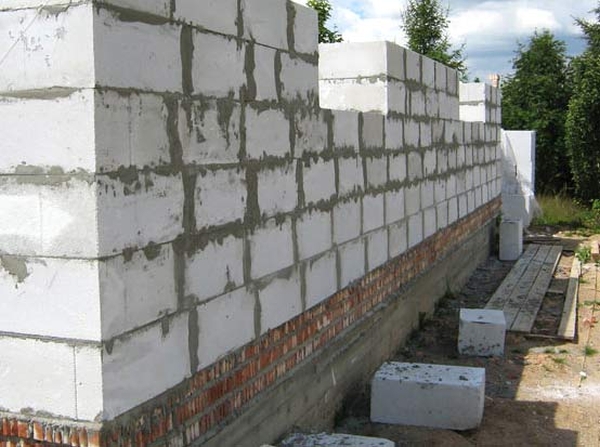Features of a house made of gas silicate blocks, advantages and disadvantages
New, in comparison with wood and brick, building materials raise a lot of questions for those who decided to build their own house. Are they suitable for housing construction? Will it be warm and comfortable? What difficulties await future owners in the construction and further operation of the house? You can answer these questions by studying the reviews of those people who already live in gas silicate houses.
The most important reason why gas silicate blocks are chosen as the main building material is their low cost. Calculations are given, according to which 1 square meter of walls made of this material costs half as much as a brick. However, based on the feedback from the owners, this is not entirely true. The cost of gas silicate directly depends on its density: for a cube of material with a density of 600 kg / cubic meter, which is optimal for external walls, you will have to pay much more than for 300 kg / cubic meter. When buying a material, it must be borne in mind that it is very fragile, and some of it may be damaged during transportation or unloading. Better to order gas silicate with a small stock.
Those who have already built a house say that the cost of building walls is external cladding. You cannot do without it, since the porous gas silicate easily absorbs water, begins to crumble and acquires an unpleasant odor. Sheathing a house made of gas silicate blocks must meet several requirements:
- do not let water through,
- let the walls breathe,
- there must be a ventilation gap between the cladding and the walls of the house,
- do not deform when the house shrinks.
Cheap foam and sand cement plaster are not suitable. Polyfoam prevents gas exchange and negates one of the main advantages of aerated concrete, and the plaster may simply not adhere to the surface of the walls. The more expensive gypsum plaster holds better, but owners complain that it becomes covered with a network of cracks if the exterior work was done before the house was completely shrunk. The result is a complete renovation of the facade, which can hardly be called economical.

Siding causes the least complaints from the owners: it meets all the requirements and can be installed immediately after the end of construction work, without waiting for the walls to settle. Facing clinker bricks are also popular, although their use significantly increases the cost of construction. When choosing any method of dry cladding, you must not forget that there must be a ventilation gap between it and the wall, otherwise mold and the smell of dampness may appear inside the house.
It will be possible to save money on the absence of insulation: porous gas silicate has a low thermal conductivity. However, for good thermal insulation, the thickness of the walls must be large enough - about 50 cm in central Russia. If the thickness of the wall is incorrectly calculated, you will still have to additionally insulate, better - with mineral basalt wool, which "breathes" and is environmentally friendly.
Should You Believe Advertising?
Manufacturers of gas silicate blocks claim that houses made of this material are warm, with an optimal microclimate comparable to a wooden house. The construction of such housing will not take much time and will not require highly qualified builders. Is it really so? Reviews of the owners of houses made of gas silicate blocks say that only partially.
Heat and air exchange in the house is provided due to the porosity of the material. The house really turns out to be warm, but in order to keep this warmth, you need to take care of protecting the walls from moisture. The ability of a house to "breathe" can be easily destroyed by sheathing it with polystyrene foam. Another important point, which is mentioned by those who built a house on their own - the seams between the blocks should be minimal, otherwise significant heat loss will occur through them.

Ease of construction depends on the geometry of the blocks: if it is flawless (error 1mm by 600mm), then it will be easy to build a house. However, only reputable manufacturers can provide such quality, and their products are not the cheapest. Also, those who are faced with the construction of a house from gas silicate blocks assure that you should not save on high-quality glue for blocks and try to replace it with cement mortar. Such a replacement will result in the seams being too thick, and the thermal conductivity and strength of the walls will suffer. Another detail - the blocks are quite heavy, it is impossible to cope with the construction alone, especially if it is impossible to build a two-story house. But blocks are cut without problems, with an improvised tool.
Pitfalls when using silicate gas
If you nevertheless decide to build a house from gas silicate blocks, then take into account a number of points that are mentioned in the reviews by those who have already become the owner of such a house.
- It is better not to build a gas silicate house above 2 floors, since the walls may not withstand heavy loads.
- After the walls of the first floor have been erected, it is necessary to make a monolithic strapping belt in order to evenly distribute the weight of the second floor and the roof to the lower blocks. Every 3 rows, the masonry is reinforced with metal mesh or special sheets.
- A house made of gas silicate blocks requires a monolithic strip foundation; it will not be possible to save money at this stage.
- Throughout the year, the block walls will shrink. You need to remember this if you plan to immediately start the interior decoration of the house: the plaster will almost certainly be covered with cracks, so it is worth stopping at wallpaper or drywall.

Should I use this material
And yet, despite some features of the use of gas silicate, most home owners from this material do not regret their choice. According to their reviews, if the walls outside the house are reliably protected from moisture, then living in such a house is quite comfortable. It "breathes", unlike sip panels, which definitely need a high-quality ventilation system. In such a house, mold does not start, the walls from the inside are not covered with condensation.
Since gas silicate blocks are easy to process, repairs inside the house are much easier to do. Grooves for wiring, channels for water pipes and heating pipes are made quickly and effortlessly. True, this pliability also has a downside: for fixing shelves and other wall furniture, cornices, special dowels are required, since ordinary dowels can simply fall out of the wall.
Gas silicate is a good choice if you need a spacious and warm home in a short time, and your budget is limited. For many owners, it has become a real opportunity to move into their home in less than a year.



